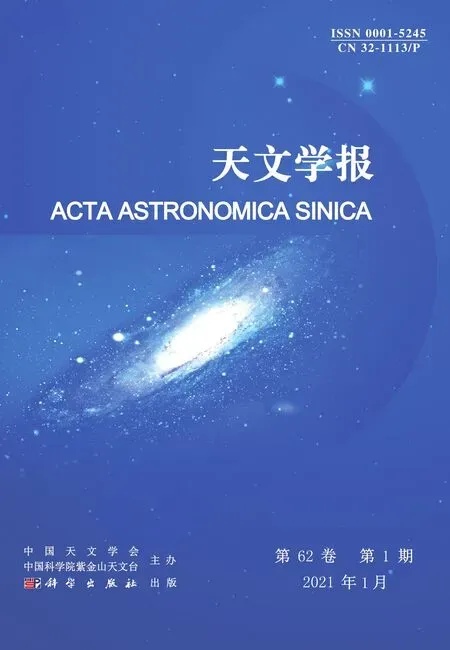宇宙大尺度结构对星系形成和空间排列的影响
2021-01-07王鹏
王鹏>
(中国科学院紫金山天文台南京210023)
星系的空间排列以及指向并非随机的. 星系的主轴和角动量与物质的大尺度分布存在一定的指向相关. 这一方向的研究将可以促进我们对结构形成机制的认识, 并提供一个独立的视角去检验星系形成过程中的环境效应. 本文就相关问题做了详细的探讨.
首先, 我们提出了一种有别于传统的大尺度结构分类方法. 该方法具有非常高的精度和效率.
其次, 通过考察数值模拟中暗物质晕(暗晕)在大尺度结构中的并合历史, 我们研究了暗晕吸积方向相对于暗晕形状和大尺度方向(物质塌缩最慢的方向)之间的关系. 我们发现, 子暗晕倾向于沿着宿主暗晕的主轴方向被吸积. 这一模式是普适的, 其一致程度随着宿主暗晕的质量增加逐渐变强. 我们还发现, 子暗晕在被吸积时, 其相对于大尺度方向之间的关系不是普适的. 小质量宿主暗晕主要倾向于垂直于大尺度方向吸积子暗晕, 而大质量宿主暗晕倾向于平行于大尺度方向吸积子暗晕. 这种“两阶段”的吸积模式打破了前人一直认为的只存在单一的“平行”吸积模式, 为解释角动量方向和大尺度方向翻转问题提供了思路.
同时, 我们还仔细研究了暗晕角动量-大尺度结构相关关系的形成和演化历史. 我们发现暗晕角动量-大尺度结构相关性中的翻转现象不仅存在于纤维状(Filament)结构中, 还存在于团块结构中(Knot),对于纤维状结构中的暗晕, 其角动量-大尺度相关性与暗晕的形成时间、迁移时间以及暗晕在纤维状结构中的质量增长率有关. 我们进一步发现, 统计上, 所有暗晕在早期的角动量方向都是倾向平行于大尺度方向, 随后逐渐向着垂直方向演化. 大质量的暗晕演化得较快, 而小质量的暗晕演化得较慢. 因此,如今小质量暗晕表现出角动量方向和大尺度方向的平行趋势, 而大质量暗晕则表现为垂直趋势. 这一演化模式与暗晕在大尺度上吸积物质方式的改变有关: 早期暗晕在垂直大尺度方向上吸积物质, 从而使得所有暗晕角动量平行大尺度方向, 随着平行大尺度方向物质吸积逐渐加剧, 暗晕角动量逐渐向着垂直大尺度方向转变.
最后, 我们考察了流体数值模拟中星系角动量-大尺度的相关性. 我们的主要发现是: 低质量、蓝色、扁圆形星系的角动量方向倾向与大尺度潮汐场中物质塌缩最慢的方向平行, 而大质量、红色、长椭形星系的角动量方向往往与大尺度方向垂直. 这些因素中,质量是主因. 在红移z=0时,从平行到垂直趋势过渡位置对应的恒星质量约为109.4h-1M ⊙、g-r颜色约为0.62、3轴形状参数约0.4. 随着红移增加, 过渡质量逐渐变小.
The spatial distribution and orientation of galaxies are not random. The direction of galaxy shape and spin are correlated with the direction of the distribution of mass on large scale. Research in this field will promote our understanding of the mechanism of structure formation and provide an independent perspective to examine the environmental effects of galaxies formation. We have discussed in detail with related issues.
First of all,we introduced an improved algorithm of classifying the large scale structure.
We then investigated the accretion history of dark matter halos in large scale structure.We studied the tendency of accretion relative to halo’s shapes and large scale structure.We find that subhalos tend to be accreted along the direction of the major axis of the host halo. This accretion pattern is universal and depends on the virial mass of the host halo.We also find that the accretion relative to the direction of large scale (the slowest direction of material collapse) is not universal. Low-mass host halos tend to accrete subhaloes from the direction that’s perpendicular to the direction of large scale structure, while high-mass hosts tend to accrete subhaloes from the direction that is aligned with the direction of large scale structure. This “two-stage” accretion mode breaks the “only parallel” accretion mode suggested in previous works, providing a solution to the problem of halo spin-flip.
Additionally,we also studied the formation and evolution of the correlation between the halo spin and the direction of the large scale structure(spin-LSS).We find that the spin flips are not only occurring in filaments but also in knots. For halos in filament, the spin-LSS correlation is related to their formation time, migration time and mass growth rate. We further found that, statistically, all halos have their spins aligned with the direction of LSS at the very early time, and then gradually evolve toward the vertical direction. High-mass halo evolves fast,while low-mass halo evolves slowly. Therefore,atz=0,low-mass halo still shows a parallel trend while high-mass halo shows a vertical trend. This evolution pattern depends on the mass accretion history during halo formation.
At last,the correlation between galaxy spin and the large scale tidal field is investigated.We mainly find that the spins of low-mass, blue, oblate galaxies are preferentially parallel to the direction of the large scale tidal field, while the spins of high-mass, red, prolate galaxies tend to be perpendicular to the direction of the large scale tidal field. Of these three properties, galaxy stellar mass is the main factor. The transition from parallel to perpendicular trend occurs at about 109.4h-1M⊙in the stellar mass,~ 0.62 in g-r color,and~0.4 in triaxiality.
